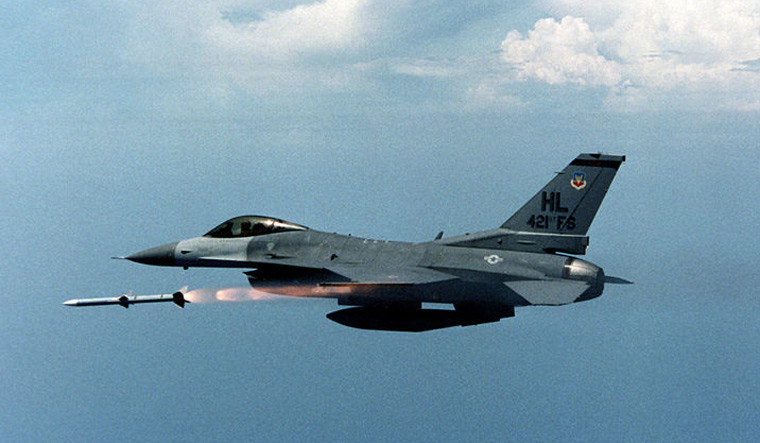“But, of course, weapons that fire only in one direction have not been made.” These were the words of V.K. Krishna Menon when he was addressing the United Nations as India's permanent representative to the world body on December 6, 1956.
Menon would repeat the same statement, with few modifications, in other speeches, mainly on the issue of the US supply of arms to Pakistan on the pretext of helping defend it against the threat of Soviet invasion. Menon’s statement seems apt in describing the current discourse of outrage in India over claims that Pakistan used US-supplied F-16 fighters and AMRAAM missiles on an offensive mission across the Line of Control.
The Indian allegations that Pakistan ‘misused’ F-16 fighters and missiles—meant for fighting terrorists—challenge the notion that the US has been strict about the use of its exported weaponry. Retired air vice marshal Mohan John explained, “The US has been known for having strict control to modifications, storage and inspection access to its weapons. It is a moot point as to how strict they would be about implementing this with respect to Pakistan.”
Referring to the history of the US sale of the AMRAAM to Pakistan, John said it was part of a deal to upgrade Pakistan’s fleet of F-16 fighters in the past decade. Pakistan signed a deal worth $284 million in 2007 to buy 500 AMRAAMs and other systems.
“India had immediately expressed concern to the US that such potent weaponry (on the F-16) could and would be used against it. The US had, at that time, assured India that this military assistance was being done under strict conditions and stipulations, including an assurance from Pakistan, that the aircraft would be used only for anti-terrorist operations,” John recalled.
However, John noted the concerns expressed by India a decade ago were, and are still, very relevant. “While the other weapons (sold to Pakistan) were air-to-ground weapons, which could well be used in anti-terrorist operations, the AMRAAM was, and is even today, a very sophisticated air-to-air missile with an engagement range of up to 100km and 'fire and forget' capability. Such a missile had no relevance whatsoever for anti-terrorist operations,” John explained.
A serial offender
The deployment of the F-16 and AMRAAM is not the first instance of misuse of a US-supplied weapon by Pakistan against India. In 2018, India complained to the US that Pakistan was using the TOW-2A anti-tank missile against bunkers across the LoC. The US provided Pakistan over 2,700 TOW-2A missiles in late 2006 for use against terrorist groups in its tribal areas.
Retired rear admiral Sudarshan Shrikhande argued the F-16 misuse saga highlighted the limitations of US enforcement and end-use verification processes. “There perhaps were certain end-use restrictions on the F-104 Starfighter jets transferred to Pakistan by the US in the 1960s. The PAF deployed them in 1965 and in 1971, albeit with not much effectiveness. These restrictions were perhaps more to assuage India than to really keep Pakistan from using them as they wished to,” recalled Shrikhande.
“The problem with becoming so restrictive (about end use of arms) is that nations will go elsewhere and buy weapons; or make it themselves,” Shrikhande argued.
John opined the real reason behind Pakistan’s ‘denial’ in acknowledging the use of the F-16 in the recent aerial engagement was the fear of upsetting the US as Islamabad had given Washington an assurance that this aircraft would be used only for anti-terrorist operations. “In addition to this, they would also have taken into account how President Donald Trump has been overtly critical about Pakistan, and its anti-terror efforts,” he added.
The Afghan shadow
Larger geopolitical factors may well spoil India’s hopes that the US-Pakistan relationship will suffer on account of the misuse of the F-16. The planned US withdrawal from Afghanistan, announced by President Donald Trump, has meant Pakistan would be seen as a major player in ensuring stability.
Shrikhande commented on the difficulty of discerning any clear American policy and strategy framework in its involvement in Afghanistan, especially after 2004-05. “The strategic aim of America’s longest war, which began 18 years ago, is still difficult to determine,” Shrikhande opined, adding this was an opinion shared by many US analysts also.
Shrikhande also felt that the long-term direction of the US-Pakistan strategic relationship is still difficult to forecast, but there is reason to believe that the two nations are closer to a point of ‘no return’ than ever before. “It is also possible that Pakistan may be a bit less central, and perhaps more marginal, of a player in Afghanistan’s future than seemed likely just a few months ago,” he explained.
John said the US will “certainly be displeased” to know its F-16s were misused by Pakistan and would convey its displeasure to Islamabad. “However, Pakistan's role in ensuring Afghan stability will be a factor that would shape the reaction from the US. The same factor will also influence future US arms sales/support to Pakistan,” John added.
The bigger picture
“Whatever restrictions the US places on Pakistan on use of its weapons, they are a small matter for India at the end of the day,” declared Shrikhande. He added India should “assume the Pakistan military would use everything, supplied by anyone, at its disposal across the spectrum of warfare,” against its larger neighbour.
He felt there was not much need for the ‘media outcry’ over the use of the F-16 and about India officially raising the issue with Washington.
also read
- Cross-border romance lands UP man in Pakistan jail
- At UN, India calls out Pakistan for ‘mischievous provocation’ and ‘political propaganda’
- Pak responsible for derailing SAARC; not going to discuss India-Pak relations: Jaishankar on SCO Summit
- T20 World Cup: Bumrah shines as India pips Pakistan in low-scoring thriller
“This was for two reasons. First, it was not yet clear what specific protocols and restrictions were placed by the US on Pakistan about permitted usage of weapons. Second, even if there are restrictions, it cannot be assumed that the Pakistan Air Force, Navy and others would adhere to them,” he added. Shrikhande asked, “Why would any country buying arms readily accept such constraints unless it was merely to make the deal?”
Given India’s poor experience in sending ‘dossiers’ to Islamabad for several years, Shrikhande argued, “rather than projecting ‘outrage’ over Pakistan's use of the F-16 and its ordnance, India should continue to be even more robust in the use of force. That would be a greater deterrent”.
Instead of extrapolating the technicalities of the 'MiG-21 versus F-16 engagement' to score points on social media, he emphasised the need to continue beefing up India's defence capabilities. “The larger lesson for us is that great powers are essentially self-reliant in military hardware. You don’t become great otherwise,” Shrikhande contended.


